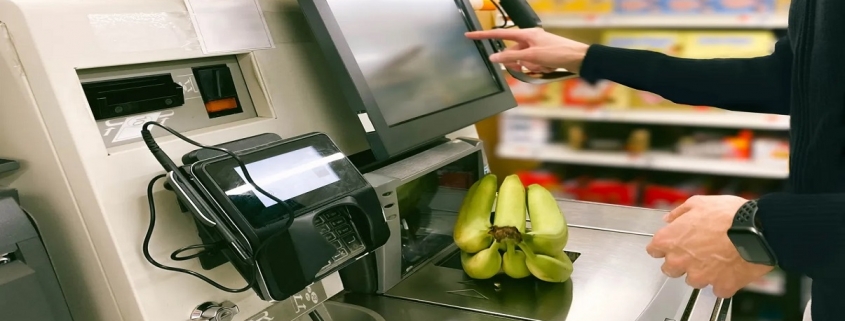The Surge in Self-Checkout Systems Market in Today’s Cashless-Driven World
The self-checkout systems market was valued at US$11.041 billion in 2020 and is projected to increase at a CAGR of 19.44% to reach US$38.295 billion by 2027.
Self-checkout systems are automated systems used in the retail, grocery, and hospitality industries to assist customers with self-ordering and checkout without the intervention of workers. Self-service checkout systems are gaining popularity due to their ability to reduce cart abandonment, ensure shorter line-ups than traditional checkout lanes, and free up staff time for other store-related chores. Self-checkout kiosks take up less area than traditional checkout registers. This means that businesses may fit more kiosks into a smaller space while maintaining the same checkout capacity. The lowering of queues further reduces the amount of space required for order processing. Small stores can save money on real estate. Massive retail chains, on the other hand, have even more opportunities to promote their luxury products. The effective implementation of a self-checkout technology can help a business differentiate itself from competitors, optimize the checkout process, and attract more customers. For years, self-checkout solutions have been critical to retail performance, particularly in grocery shops and supermarkets. The global popularity of self-checkout systems has expanded dramatically as a result of retailers’ increasing emphasis on improving consumer happiness and the shopping experience. Furthermore, as investments in improving the patient experience have increased, it has become increasingly frequently used in the healthcare industry.
Increasing automation to expand the market for self-checkout systems
In several worldwide areas, automation is rapidly replacing conventional forces of transformation. Automation is a type of technology that mechanizes a repetitive operation, minimizing the need for human help. Automation can refer to anything from self-checkout lanes at the supermarket to automated teller machines (ATMs) at banks. Self-checkout systems are expected to become more common in warehouses and shop operations as automation spreads throughout industries and organizations such as retail and hospitality. Self-ordering, self-scan and pay, and other features that decrease long line-ups are all contributing factors to their growing market popularity. As a result of the diminishing workforce, the adoption of robotic and automated items has also expanded dramatically in the retail sector over the last several years. Even though some industries have been sluggish to accept automation, there has been an increase in investment in automation globally. According to International Trade Administration, USA, the United States has regularly been chosen as the location for industrial activities by large, international corporations. In reality, manufacturing-related foreign direct investment (FDI) in the United States accounted for 40.1% of all FDI in the country in 2019, and automation is essential to luring this investment and generating employment. Because of technology developments and increased investments in the retail sector, the industry is expanding at a steady rate.
The advancement of retail in-store transformation also adds to growth
Shop owners are progressively investing in technology to address inventory mapping, product information identification, payment, and customer experience difficulties in-store. Retailers prefer modern hardware systems to traditional checkout systems. The most recent hybrid self-checkout systems have enhanced security measures, high-capacity coin dispensing devices, and an intuitive consumer interface, as well as multi-item scanning and cashless transactions. For instance, Fujitsu Frontech North America Inc., a retail technology provider, introduced U-Scan Elite, its sixth-generation self-checkout device in April 2021. U-Scan Elite, built on the Fujitsu cash automated system Smartcash, is intended to provide a small footprint, high-capacity bill, and coin recycling self-checkout solution. The implementation of self-checkout systems assists customers in understanding various product features and promotional offers available in the store and checking out fast without the assistance of the personnel. As a result, self-checkout systems serve as an additional touchpoint for store owners, allowing them to improve client interaction and enhance their shopping experiences. Furthermore, the growing consumer preference for both cash and cashless transactions is forcing shops to install new systems with enhanced capabilities.
The popularity of digital payments is driving a lot of traction for cashless self-checkout systems solutions
Cashless solutions are gaining popularity as consumers’ demand for digital payments and electronic transactions grows. Despite the dominance of cash or paper-based payment transactions, there is a growing preference for electronic payments among middle-aged customers and millennials. The COVID-19 epidemic has accelerated financial inclusion, resulting in significant growth in digital payments in tandem with the global expansion of formal financial services. According to a press release by the WHO in June 2022, the pandemic has increased the use of digital payments. Over 40% of adults in low and middle-income nations made merchant in-store or online payments using a card, phone, or the internet for the first time since the pandemic began. More than a third of adults in all low- and middle-income economies paid their power bills straight from a formal account. Following the outbreak, more than 80 million adults in India and over 100 million adults in China made their first digital merchant payment. Furthermore, the availability of digital payment options and the growing trend of mobile commerce are pushing the cashless self-checkout systems segment.
COVID-19 Insights
The COVID-19 pandemic has had a detrimental influence on the market due to required government limitations and the closure of malls, shops, retail stores, and hypermarkets. For a time, the hardware supply chain was disrupted due to lockdowns in various countries and difficulty in import-export transactions. These had a huge impact on the Self-checkout system’s global manufacturing facilities. On the plus side, during the COVID-19 pandemic, the urge to preserve social distancing, reduce waiting time, and provide products outside of retail shop premises fuelled overall industry growth. The market is primarily driven by rising retail space costs and longer consumer lines to order or check out. Furthermore, a lack of qualified laborers in developing countries, growing labor prices, relaxation on lockdown, and a need for individualized shopping experiences are some of the major factors driving market expansion.



